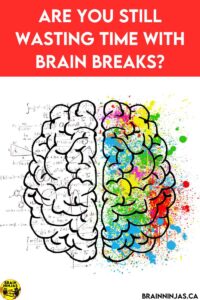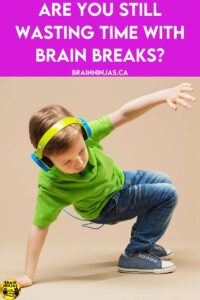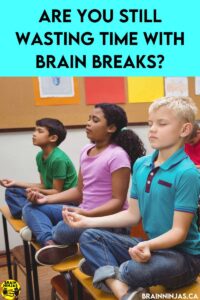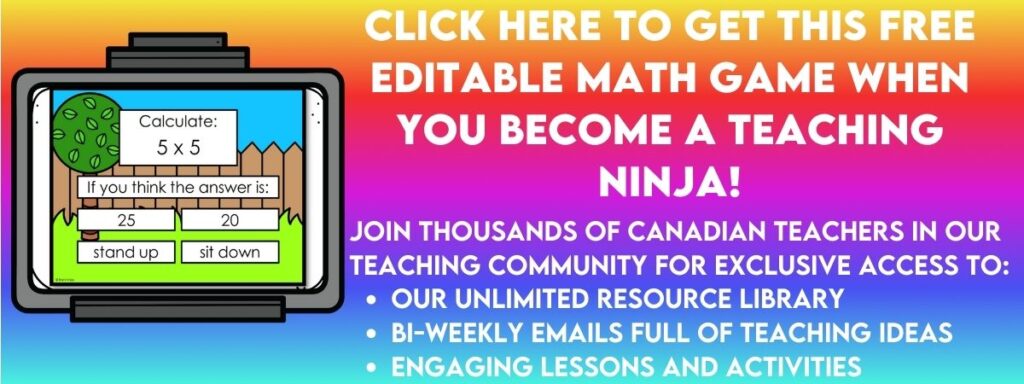
Do you find that brain breaks are disrupting your learning and working time? Do students seem more stimulated after a brain break? Is it difficult to get them calmed back down? Maybe you’ve been using brain breaks wrong? Stop wasting your learning time with brain breaks by managing them differently.
What is a brain break?
There has been lots of hype over the past few years that students need lots of breaks to keep their brains stimulated and working, but without understanding how kids really work, those breaks could be disrupting their learning and could be preventing them from building any sort of stamina.
A brain break is supposed to be a short break from a task to help refocus or reset the body and brain so work can resume. A short break implies that it should take 1-5 minutes. and a break implies that the activity should not require extensive set-up or calming down after.
What are some of the pros of brain breaks?
When used properly, brain breaks can help people work for longer periods of time or work more productively by staying focused. A brain break is not a break from learning. It is just refocusing the mind so that it can work better. It really shouldn’t be called a break at all.
Understanding and using the best brain breaks for the learners in your classroom can be proactive for some behaviours. It is not a quick fix, but it can help teach some students how to regulate and become better at managing their moods. Learn more in our posts: 13 Ways to Deal With Behaviours Without Taking Away Recess or How to Chuck the Classroom Management Charts.
What are the different types of brain breaks?

Physical Movement
A break could be as simple as standing and stretching. It does not need to be a short run or dance break. Adults use physical breaks every time they adjust how they sit in a chair. Think of physical breaks as adjusting the body so it’s more comfortable and is ready to work again.
Mindfulness Exercises
Simple breathing exercises or a short meditation can help get the brain back on track. Sometimes adults will make a note on a piece of paper so their mind can be cleared to focus on a task. Mindfulness can also be self-talk, like prepping for a meeting with the boss or reminding yourself of the steps to solving a problem. Think of mindfulness as preparing the mind to work.
Sensory Activities
These types of breaks often involve using textures like clay or fidgit tools to help get some of the wiggles out. It can be as simple as running hands over carpet or using a bit of slime to squeeze for a few minutes. Adults often use sensory breaks when they change the volume of the radio or take off their sweater because they are too warm. Think of sensory breaks as adjusting the environment to make it easier to focus.
What Are the Cons of Brain Breaks?
Honestly, there are few cons to using brain breaks, but only if you are not using them as intended.
If your brain break takes time to set up or take down, then it’s likely not a brain break. Do the kids look at brain breaks like a party in the middle of class? If your students need time to reset after the break and get back into work mode, then it is also likely not a brain break. The more time and energy used to do the brain break, the less it will actually help in calming your students and getting them back to work.
We had discussions with several teachers who said that brain breaks didn’t work in their classrooms and found that they had several things in common:
- they took too much time. On average, these breaks took 10-15 minutes. That’s a lot of wasted learning time.
- they were loud. Students were making noise or listening to loud and disruptive music.
- they were too physical. Students needed to get drinks or take a break from their break.
- there was too much sensory overload. Flashing lights, loud sounds, too much movement or too much excitement caused some students to become even more disruptive.
- they’re boring and I don’t know what to do; they were happening too often.

If you are seeing some traits in common with your brain breaks and they aren’t working, you might not actually be using a brain break properly. Longer breaks or ones that use equipment are much better put to use during recess or physical education. Students should be given a proper amount of time to move, make noise and deal with sensory issues where there is a little less structure, like during recess. Most recess breaks average fifteen minutes, and you should encourage your students to move and make noise in the most spectacular fashion.
But those types of breaks aren’t brain breaks.
What type of brain breaks do you need?
Think of your work day. Even adults do not sit and work all day long without any breaks. You might stop to look at your phone or go to the washroom. A quick snack or listening to some calming music. You might even take a moment to make a quick phone call or check in with a coworker. Even just taking a moment to look out the window can be enough to reset.
We think of these types of breaks as normal for most workplaces. Somehow, when working with children in our fast-paced internet and Pinterest world, we took those simple breaks and made them into events that break up the day.
One teacher talked about how excited the kids were after each dance break, but that it was eating up too much class time. I asked why she was doing four dance parties a day. She honestly thought these were brain breaks.
No wonder kids can’t work.
Where to Start With Brain Breaks
Different types of breaks will work for different types of students. You might find that not all your students need every type of break.
Teach the Whole Class How and Then Use it Individually
Brain breaks shouldn’t be so disruptive that the whole class needs to use them at the same time, but when you are first introducing breaks and new strategies, it can be helpful to teach them to the whole class at once. Teaching students how to use a break properly means they can start to monitor their own needs and then use the breaks as needed without stopping the whole class from working.
Build Breaks Into the Learning
Sometimes the types of activities you schedule throughout the day can naturally create brain breaks without losing learning time. For example, play a game during math where students can move.
We created a simple math game where students sit or stand based on the answer. The game is editable so you can change out the equations to whichever operations or numbers you want to use. We’ll send the Sit and Stand Math Game to your inbox when you sign up for our email list. If you’re already on the list, you can find the game in the Resource Library.
Teach Students How to Keep a Break Simple
For example, we allow students to have a small snack while they work independently. We have discussions about what a small snack is or isn’t and when it would or would not be appropriate. For example, having a buffet is not okay. Having a crumbly or sticky snack while working with a computer is not allowed. But, having two crackers while reading quietly would be fine. Our only rule is that students clean up and eat discreetly enough that no one else notices.

For those students who need a little wiggle, give them an errand. They can take something to the office or another classroom. Let them go to use the washroom. Some kids just need to move a bit, and allowing one student to get their break while the rest keep working will help kids learn to monitor their own time.
Use the volume strategically. Instead of turning up the volume, turn it way down. Use quiet, calming music and a soft volume so students need to focus on listening rather than moving or talking. Just redirecting their focus can be a break.
Teach Breathing Exercises
Teach students how to do breathing exercises. Some easy ones for kids are taking deep breaths. Use a straw and take a deep breath that fills your belly. Using the straw helps teach people how to pull the air deep into the belly. Breathe out slowly enough that it takes a long time to release all the air.
Another breathing exercise is box breathing (also known as square breathing). Inhale for a count of four, hold for a count of four, exhale for a count of four, and then hold for a count of four again. This one takes practice. You can teach this to the whole class while they sit in their chairs or, if they’re already on the ground, they can lie down. This is a great one right after a recess break or gym class to help get students calmed.
Use Meditative Activities Like Doodling or Colouring
Activities like doodling and colouring can be meditative for many people. We use colouring in our classroom often to give students a quiet activity they can do anytime between learning activities.
Use our collaborative posters to give students a purpose while letting them colour. We like to have one poster on the go each month. At the end of the month, we switch out the finished poster on the bulletin board and start a new one. Learn more in our post Five Ways to Use a Collaborative Poster. One of our favourite posters celebrates kindness with the quote “Be the sunshine on someone’s rainy day.” Find it in our TpT Store ($USD) or our BN Shop ($CAN).
Ask Students What They Need
One fun game we made up was “Covert Brain Breaks.” We asked students to think about something they did to help them refocus. Then, the goal was to try to do it without anyone else in the class catching on.
For example, one student took off their shoes under their desk and rubbed their feet together. Then they put their shoes back on. This was a great example of a sensory break that didn’t disrupt anyone else, and it was simple. In fact, the student didn’t even need to move out of their seat.
Make a list of brain break ideas in your classroom and post it so students can refer to it. They’ll figure out which ones they prefer. You can even turn the list into a simple checklist so students can test them out and avoid the ones that don’t work for them. They may also find that some breaks are better during some tasks than others.
For example, just writing this post, I took a quick stroll around the room before coming back to finish writing. But, I know that having music on in the background is too much of a distraction for me while I’m writing. That’s a better tool when I’m colouring or checking emails.
Remember that having a toolbox full of brain break ideas doesn’t mean you need to use them all at once or even at all. Don’t teach students the ones that you know will set them off or cause issues. You know your students best.
Build Stamina

Students will need fewer breaks once they have built some stamina. This is something that will take time, especially at the beginning of the year.
Use stopwatches or timers to help build stamina between breaks. Start by looking at the schedule. Recess, lunch, and gym class provide natural breaks during the day. Any time your class needs to move to another location, such as the music room or library, is another chance for a bit of movement. Look at the time in between those breaks and the types of activities students will be doing. If there is a long period of time where students will be working, build in opportunities for small breaks.
For example, if your students are doing a test, give them permission to stretch in their seats halfway through, or lead a breathing exercise. Keep this break very quiet so that people who don’t need the break can keep working without being disrupted. This lets people know it’s okay not to need the break yet, but also keeps the people taking the break from being overly loud or disruptive since some classmates are still working.
Use a stopwatch (only because a timer will often sound) to see how long students can work without a break on a regular basis. We generally start with 10-15 minutes and try to build to 20-30 minutes. We set a goal and explain that we want to see how long students can work without a disruption. If a student uses a brain break that doesn’t stop others from working, we keep the timer going. But, if the break causes others to stop working because they were disrupted, then we stop the timer. The goal then becomes trying to beat the time each time we have a focused work session.
At the beginning of the year, build in breaks where they fit naturally. As the year progresses, rely on what you observe or when students ask to put in breaks. If you’ve done this correctly, you’ll see students using the tools when they need them without causing the whole class to stop working.
Stamina is one of those skills that students of the digital age are severely lacking. They are used to short snippets of entertainment, but it is a skill that can be taught. You may need to start with working for 2 minutes. Keep at it, especially at the beginning of the year. It does pay off, but it is taking longer and longer each year to get students on task and to keep them focused.
Test, Try and Change
The most important thing to remember is to try things out and see what works. If it doesn’t work once, change something up such as the length, the intensity or the number of students using it. Don’t give up right away.
Do you have any brain break tips? Share them with us in the comments below.







